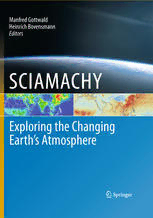
SCIAMACHY - Exploring the Changing Earth’s Atmosphere PDF
Preview SCIAMACHY - Exploring the Changing Earth’s Atmosphere
Manfred Gottwald Heinrich Bovensmann Editors SC IAMACHY Exploring the Changing Earth’s Atmosphere SCIAMACHY - Exploring the Changing Earth’s Atmosphere Manfred Gottwald Heinrich Bovensmann (cid:129) Editors SCIAMACHY - Exploring the Changing Earth’s Atmosphere Editors ManfredGottwald HeinrichBovensmann ResearchScientist ResearchScientist RemoteSensingTechnologyInstitute(IMF) InstituteofEnvironmentalPhysics(IUP) GermanAerospaceCenter(DLR) InstituteofRemoteSensing(IFE) Oberpfaffenhofen UniversityofBremen D-82234Wessling Otto-Hahn-Allee1 Germany D-28359Bremen Germany Cover: Earth’s limb at sunrise as seen from the ISS (photo: NASA), global NO (Courtesy: A. Richter, 2 IUP-IFE,UniversityofBremen)andglobalCO(Courtesy:Gloudemansetal.2009)columndensities. Frontispiece:TheEarth’sstratosphereasseenfromtheSpaceShuttle.Overlaidisapartofanearthshinespectrumas recordedbySCIAMACHY(photo:NASA). Thecopyrightofallillustrationsremainswiththeoriginators. ISBN978-90-481-9895-5 e-ISBN978-90-481-9896-2 DOI10.1007/978-90-481-9896-2 SpringerDordrechtHeidelbergLondonNewYork #SpringerScience+BusinessMediaB.V.2011 Nopartofthisworkmaybereproduced,storedinaretrievalsystem,ortransmittedinanyformorbyanymeans, electronic,mechanical,photocopying,microfilming,recordingorotherwise,withoutwritten permissionfromthe Publisher,withtheexceptionofanymaterialsuppliedspecificallyforthepurposeofbeingenteredandexecutedona computersystem,forexclusiveusebythepurchaserofthework. Printedonacid-freepaper SpringerispartofSpringerScience+BusinessMedia(www.springer.com) We dedicate this book to our beloved SCIAMACHY team member Dr. Annemieke Gloudemans, who recently passed away at the age of 35 years. She will always be remembered for her kind personality and through her invaluable contributions to the challenging analysis and interpretation of SCIAMACHY carbon monoxide measurements. Editorial In March 2002 the atmospheric science instrument SCIAMACHY was launched on-board ESA’s ENVISAT mission into low-Earth orbit. It was, and is still, one of the major current Earth Observation undertakings of Germany, The Netherlands and Belgium, accomplished in cooperation with the European Space Agency (ESA). Having meanwhile successfully monitored and explored the Earth’s atmosphere for more than 8 years with SCIAMACHY, theinvolvedscientificinstitutesandspaceagenciesfeelthatitisworthtoissueacomprehen- sivepublicationdescribingtheSCIAMACHYmission–fromtheveryfirstideastothecurrent results.ThetargetedreadershipisnotonlytheexistingandpotentiallynewSCIAMACHYdata users from undergraduate student level up to researchers new in the fields of atmospheric chemistryandremotesensingbutanyonewhoiskeentolearnaboutSCIAMACHY’seffortsto studytheatmosphereanditsresponsestoboth,naturalphenomenaandanthropogeniceffects. Thefirstchapterexplainsbrieflywhyitisnecessarytomakemeasurementsfromlow-Earth orbittostudytheatmosphere.Theglobalviewsfromanaltitudeof800kmopennewwindows to observe large-scale phenomena which are of prime importance to understand today’s changing atmosphereandclimate.Thisintroductorychapter setsthestage fortherestofthe publication.HavingsummarisedwhySCIAMACHYwasselectedtobelaunchedintospace, Chapter 2 takes a closer look at the ENVISAT mission, which hosts SCIAMACHY. The purpose of Chapter 2 is to describe those aspects of ENVISAT being of relevance to the SCIAMACHY mission. The location on and the environment of the platform, together with the ENVISAT orbit, determines many aspects of the instrument’s design and operation. Similarly the concepts for data downlink and handling in the ground segment specify how measurementdataisreceived,processedanddisseminatedingeneral. A detailed description of the instrument concept is the subject of Chapter 3. It permits insightintooptical,thermalandelectronicsubsystems.Mainemphasisisgiventotheoptical paths since they collect and generate the spectral signals containing the information on geophysical parameters thus being prime responsible for the achieved data quality. In order toprovidethereaderwithanideaaboutthechallengesofinstrumentdevelopment,chapter3 also outlines the history of how SCIAMACHY was built. Without a flexible operations concept however, all the sophisticated instrument functionalities would have been useless. How SCIAMACHY is operated in-orbit can be found in Chapter 4. The chosen operations approachallows,despitetheinstrumentcomplexity,fullexploitationofitscapabilitiesinawell structuredoperationsenvironmentthussupportingtheneedforlong,stablemeasurementsas required in atmospheric and climate research. In Chapter 5, the various steps necessary to calibratetheinstrument,on-groundandin-orbit,arepresented.Calibrationisrequiredtofully characterise the optical paths. Additionally, Chapter 5 also addresses optical performance monitoringwhichpermitsquantificationofthedegradationofopticalcomponents.Calibration andmonitoringtogetherensurethattherecordedsignalsaretransformedintowellcalibrated spectra–aprerequisiteforretrievinggeophysicalparameterswithhighaccuracyoverthefull missionlifetime. vii viii Editorial Chapter 6 brings the more technical part of the publication to a close. It describes SCIAMACHY’s in-orbit mission lifetime, starting with the launch and the Commissioning Phase and illustrates now more than 8 years of routine measurements. Various instrument characteristics, derived from the monitoring activities, are presented and show the excellent in-orbitbehaviour.Wealsooutlinehowin-orbitdegradation,aphenomenoncommontoeach longdurationspacemission,impactsSCIAMACHY’smeasurementsanddemonstratehowit canbecorrectedorcompensated. WithChapter7thesciencerelatedinformationisintroducedbysummarisingtheprinciples andmethodsforthederivationofgeophysicalparametersfromthemeasuredspectra.Whilein the early years of the mission the retrieval methods were mostly relying on standard algo- rithms,thescientificingenuityhasmeanwhilegeneratedawealthofnoveltechniquespermit- ting the retrieval of geophysical parameters beyond the original ideas. This chapter can be regardedasthebasisformostoftheSCIAMACHYdataprocessingandscientificresultsbeing describedinthenextsections. Operational and scientific data products are the subject of Chapter 8. The reader learns which products are generated under ESA responsibility and which are provided by research institutions involved in SCIAMACHY. For the ESA generated products, the strict require- mentsandimplementationsoftheoperationalprocessingenvironmentareoutlined.Asevery geophysicalparameterretrievalrequireswellcalibratedmeasurements,wealsoreportonhow calibration and monitoring information is used to derive earthshine, extraterrestrial radiance andirradiancedataproductsfromtherawsignals. Retrievedgeophysicalparametersdonotnecessarilyimmediatelytranslateintoatmospheric science results. It has to be proven first that the data products are of sufficient quality. This process of product validation, subject of Chapter 9, was an enormous effort in the first years of the mission and is required, at an adequate level, throughout the mission and even beyond to create long-term datasets of known quality relevant for environmental, atmo- spheric, and climate change research. Chapter 9 explains the selected validation proce- dures, associated teams and summarises results acquired so far. Chapter 10 concludes the publication by presenting SCIAMACHY’s unique view of the changingEarth’senvironment.Thecapabilitiesoftheinstrumentpermitstudyingphenomena rangingfromthetheatmosphericlayerwherewearelivingin,i.e.thelowertroposphere,upto the mesosphere and lower thermosphere where solar-terrestrial interactions begin toprevail. However SCIAMACHY does no longer stop at the bottom or top of the atmosphere. Even Earthsurfaceparameterslikevegetationorphytoplanktonpropertiesarenowwithinreachas wellasmonitoringthesolaractivity.FinallySCIAMACHYhasprovensurprisinglysuccess- fulinacquiringspectralsignalsfromtheatmosphereofourneighbourVenus.Thecontentof Chapter 10 nicely illustrates the success achieved up to now and justifies continuing invest- mentsintheSCIAMACHYmissionanddatausage.Althoughweintendedtobeascomplete aspossibleintheframework ofthisbook,Chapter10isstillasummaryonly.Thereforethe interestedreaderisreferredtothereferencesgiveninthisbookandthewebsiteslistedbelow allowingadeeperlookintoSCIAMACHYresults: http://envisat.esa.int/ http://www.sciamachy.de/ http://www.sciamachy.org/ http://www.iup.uni-bremen.de/ http://joseba.mpch-mainz.mpg.de/ http://www.temis.nl/ http://wdc.dlr.de/ The SCIAMACHY project is and has been an important milestone in Earth Observation as it has already yielded unique scientific insights into the working of the Earth system. Many people have contributed to it. With the exception of the Principal Investigator JohnP.Burrows,whopushedtheprojectsinceover25years,theycannotallbenamedhere Editorial ix but we intended to make clear that the mission is a team effort combining expertise from agencies,industryandscience. Theeditorswouldliketothankallinvolvedinthepreparationandcarefulreviewingofthis publication.Wehopethattheresultiswellreceivedbythereaders. ManfredGottwald HeinrichBovensmann November2010
